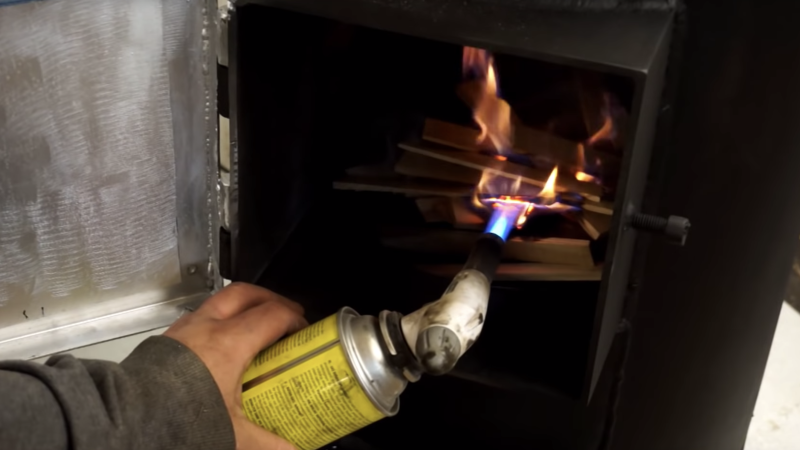For poor [workshop from scratch], winter brings the joy of a cold workshop. Since the building is structurally made from tin, warming up the room is difficult.
Naturally, the solution was to construct a homemade wood furnace. The build starts off with an angle grinder being taken to a compressed air tank. After sawing off the top and sanding down the edges, the builder slices out an opening and welds together some rods into a stand for the center. He then proceeds to weld some external frames for the furnace, as well as a chimney stack, some nifty covers joined by hinges, and a fan/temperature regulator to keep the fire going.
Most of the pieces seem to come from scrap metal lying around the workshop, although the degree to which the entire project comes together is quite smooth. Some filter and spray paint do the trick for cleaning up the furnace and making it look less scrappy. The last step? A stack of wooden logs and a blow torch to start the fun. Outside of the furnace, an LCD screen keeps track of the temperature, giving some feedback and control.
The result is perhaps a too effective at warming up the workshop, but the problem sure is solved!
















Nice, but it would be more efficient if the combustion air was from the outside and not the heated air in the room
Sufficiently more efficient to be worth the hassle? I wonder.
One of the big increases in efficiency for already leaky buildings is that you’re not pulling in cold air from outside to replace the air used in combustion. I’ve got a BigMaxx heater out in my pole barn shop and you can feel a cool breeze coming in near the heater when it’s running replacing hot air that went up the stack.
Wouldn’t that make it LESS efficient? Freezing air from outside?
Cleaner, oxygen full air yes. But colder. Brrrrrrr
The problem with drawing combustion air from inside is the fact that it must then be vented outside once it’s post-combustion. This means that the room as a whole is under a slight negative pressure which means that air to replace the air that was burned comes in through the leaky parts of the structure, direct from outside (i.e. cold!).
The better alternative is to draw cold air directly to the furnace, vent smoke out, and keep the room sealed with the warm air the furnace makes.
I keep thinking of doing that but then out place would just be even hotter. The down fall of a wood fire is there is no thermostat. But even if there was … you know what It’s like husbands :lol:
I don’t have a lot of practical experience with wood furnaces, but can’t you control the burn rate by throttling the input air stream? Less oxygen = less fire.
You can’t burn cold / low-oxygen, because it makes the combustion really dirty. It’s inefficient and bad for particulates, the air, etc.
Instead, burn hot and store the heat to be played out slowly. Which, it turns out, is super-old tech.
https://en.wikipedia.org/wiki/Masonry_heater
These things are all over in Germany. I’d never seen one before as an American. You fire it up in the morning, and it’s putting off a nice mellow heat through the evening.
Nice, very nice.
But why burn isolation material (the wood) instead of putting it up onto the tin walls?
It burns down in just one day, o.t.o.h. it isolates many years… yes: it keeps also the heat out in summers.
Even if this was done in multiple takes, dude has crazy fab skills. Cool to watch.
Agreed, extremely nicely done video, and mesmerizing fab skills to watch. Nice to see a video that’s not a lot of fluff, and just gives you the meat of what you are interested in seeing.
+1. mad skills.
My only comment is that the thinnest piece in the whole build is the firebox, which means he’ll get to do it all over sooner rather than later.
Nice build but what he did is essenntialy illegal after Poland introduced new anti-smog laws is 2019.
they make catalytic converters for wood stoves that essentially eliminate unburned CO
Yeap, mesmerizing viewing … a skillful worker doing a marvelous work and me sitting and watching … :)
I looked at a house that had a wood fired forced-air furnace. Had a hopper that you’d stack splt logs in (They had to be a certain size but the hopper had a removable template that you’d use to size your split wood, it would also burn prestologs) and then the furnace would feed the logs in one at a time into the combustion chamber. If memory serves me it had an electric ignitor that’d light the wood, similar to a pellet stove ignitor but scaled up. I wish I had gotten pictures of it, it was quite fascinating how it all worked, and I’ve never seen such a thing since. (Although, pellet-fired forced-air furnaces DO exist, Home Depot sells them, among other places)
FWIW, a well-built rocket mass heater would be *far* more efficient at heating him while almost eliminating pollutants.